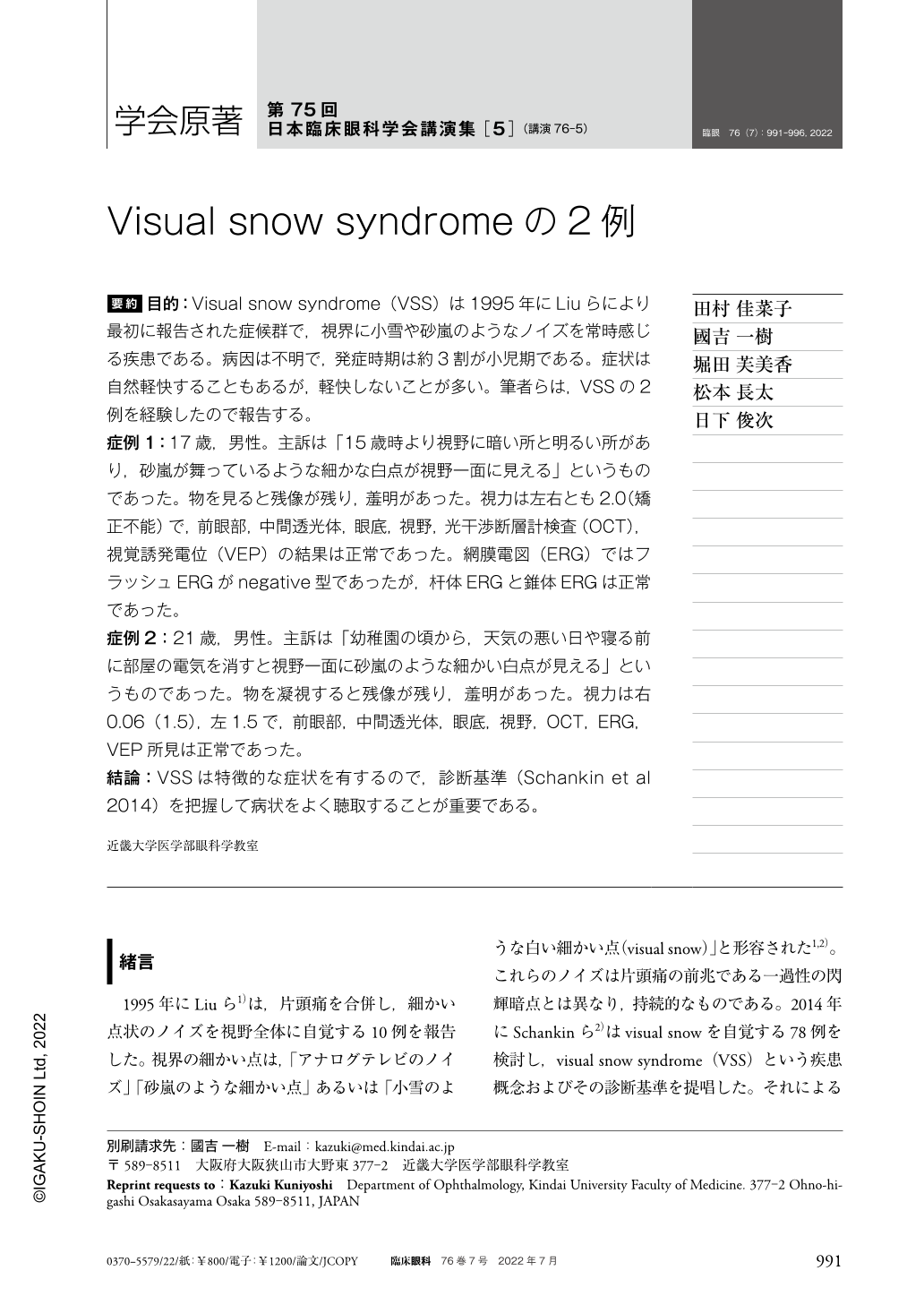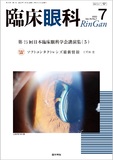Japanese
English
- 有料閲覧
- Abstract 文献概要
- 1ページ目 Look Inside
- 参考文献 Reference
要約 目的:Visual snow syndrome(VSS)は1995年にLiuらにより最初に報告された症候群で,視界に小雪や砂嵐のようなノイズを常時感じる疾患である。病因は不明で,発症時期は約3割が小児期である。症状は自然軽快することもあるが,軽快しないことが多い。筆者らは,VSSの2例を経験したので報告する。
症例1:17歳,男性。主訴は「15歳時より視野に暗い所と明るい所があり,砂嵐が舞っているような細かな白点が視野一面に見える」というものであった。物を見ると残像が残り,羞明があった。視力は左右とも2.0(矯正不能)で,前眼部,中間透光体,眼底,視野,光干渉断層計検査(OCT),視覚誘発電位(VEP)の結果は正常であった。網膜電図(ERG)ではフラッシュERGがnegative型であったが,杆体ERGと錐体ERGは正常であった。
症例2:21歳,男性。主訴は「幼稚園の頃から,天気の悪い日や寝る前に部屋の電気を消すと視野一面に砂嵐のような細かい白点が見える」というものであった。物を凝視すると残像が残り,羞明があった。視力は右0.06(1.5),左1.5で,前眼部,中間透光体,眼底,視野,OCT,ERG,VEP所見は正常であった。
結論:VSSは特徴的な症状を有するので,診断基準(Schankin et al 2014)を把握して病状をよく聴取することが重要である。
Abstract Purpose:Visual snow syndrome(VSS)was first reported by Liu et al in 1995. VSS is characterized by persistent positive visual phenomena, including numerous small particles scattered in the entire visual-field, described as “visual snow”. The symptoms begin in childhood in 30% of all patients, are persistent, and last from months to years. Herein, we report two patients with VSS.
Case 1:A 17-year-old man visited our clinic with complaints that he had been seeing dark and bright areas in the visual field, and numerous small white dots were always visible in his visual field diffusely, just as if he was in a sandstorm since he was 15 years old. He also reported afterimages and photophobia. His decimal visual acuity was 2.0 in both eyes. Examinations of the anterior segments and fundi of the eyes, visual field, optical coherence tomography(OCT), and visual evoked potential(VEP)were within normal limits. Flash electroretinogram(ERG)showed reduced b-wave, resulting in negative ERG, whereas rod and cone ERGs were normal.
Case 2:A 21-year-old man visited our clinic with complaints that he had been seeing numerous tiny white dots in his entire visual field all the time, especially on cloudy days or in dark places, since his childhood. He also complained of afterimages and photophobia. His corrected decimal visual acuity was 1.5 in both eyes. Results of the examinations of the anterior segments and fundi of the eyes, visual field, OCT, ERG, and VEP were unremarkable.
Conclusions:While both patients satisfied the VSS diagnostic criteria, they presented various kinds of visual symptoms. A careful interview with the patients based on the diagnostic criteria of the VSS proposed by Schankin et al in 2014 is needed for the diagnosis of VSS.

Copyright © 2022, Igaku-Shoin Ltd. All rights reserved.


